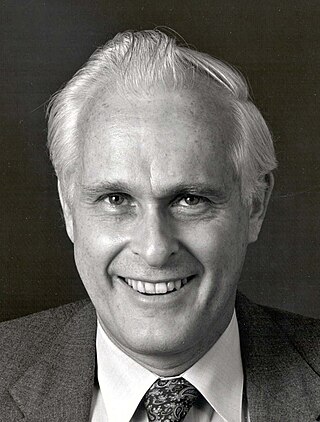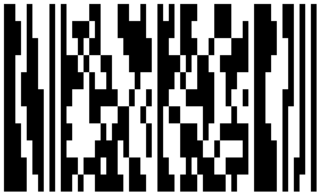
The Universal Product Code is a barcode symbology that is widely used worldwide for tracking trade items in stores.

A barcode or bar code is a method of representing data in a visual, machine-readable form. Initially, barcodes represented data by varying the widths, spacings and sizes of parallel lines. These barcodes, now commonly referred to as linear or one-dimensional (1D), can be scanned by special optical scanners, called barcode readers, of which there are several types.

Code 39 is a variable length, discrete barcode symbology defined in ISO/IEC 16388:2007.
A check digit is a form of redundancy check used for error detection on identification numbers, such as bank account numbers, which are used in an application where they will at least sometimes be input manually. It is analogous to a binary parity bit used to check for errors in computer-generated data. It consists of one or more digits computed by an algorithm from the other digits in the sequence input.

The Electronic Product Code (EPC) is designed as a universal identifier that provides a unique identity for every physical object anywhere in the world, for all time. The EPC structure is defined in the EPCglobal Tag Data Standard, which is a freely available standard. The canonical representation of an EPC is a URI, namely the 'pure-identity URI' representation that is intended for use when referring to a specific physical object in communications about EPCs among information systems and business application software.

PDF417 is a stacked linear barcode format used in a variety of applications such as transport, identification cards, and inventory management. "PDF" stands for Portable Data File. The "417" signifies that each pattern in the code consists of 4 bars and spaces in a pattern that is 17 units (modules) long. The PDF417 symbology was invented by Dr. Ynjiun P. Wang at Symbol Technologies in 1991. It is defined in ISO 15438.

Code 128 is a high-density linear barcode symbology defined in ISO/IEC 15417:2007. It is used for alphanumeric or numeric-only barcodes. It can encode all 128 characters of ASCII and, by use of an extension symbol (FNC4), the Latin-1 characters defined in ISO/IEC 8859-1. It generally results in more compact barcodes compared to other methods like Code 39, especially when the texts contain mostly digits. Code 128 was developed by the Computer Identics Corporation in 1981.

Price look-up codes, commonly called PLU codes, PLU numbers, PLUs, produce codes, or produce labels, are a system of numbers that uniquely identify bulk produce sold in grocery stores and supermarkets. The codes have been in use since 1990, and over 1400 have been assigned. The codes are administered by the International Federation for Produce Standards (IFPS), a global coalition of fruit and vegetable associations that was formed in 2001 to introduce PLU numbers globally.

Interleaved 2 of 5 (ITF) is a continuous two-width barcode symbology encoding digits. It is used commercially on 135 film, for ITF-14 barcodes, and on cartons of some products, while the products inside are labeled with UPC or EAN.
The Global Trade Item Number (GTIN) is an identifier for trade items, developed by the international organization GS1. Such identifiers are used to look up product information in a database which may belong to a retailer, manufacturer, collector, researcher, or other entity. The uniqueness and universality of the identifier is useful in establishing which product in one database corresponds to which product in another database, especially across organizational boundaries.

GS1 is a not-for-profit, international organization developing and maintaining its own standards for barcodes and the corresponding issue company prefixes. The best known of these standards is the barcode, a symbol printed on products that can be scanned electronically.

The International Article Number is a standard describing a barcode symbology and numbering system used in global trade to identify a specific retail product type, in a specific packaging configuration, from a specific manufacturer. The standard has been subsumed in the Global Trade Item Number standard from the GS1 organization; the same numbers can be referred to as GTINs and can be encoded in other barcode symbologies defined by GS1. EAN barcodes are used worldwide for lookup at retail point of sale, but can also be used as numbers for other purposes such as wholesale ordering or accounting. These barcodes only represent the digits 0–9, unlike some other barcode symbologies which can represent additional characters.
Codabar is a linear barcode symbology developed in 1972 by Pitney Bowes Corp. It and its variants are also known as Codeabar, Ames Code, NW-7, Monarch, Code 2 of 7, Rationalized Codabar, ANSI/AIM BC3-1995 or USD-4. Although Codabar has not been registered for US federal trademark status, its hyphenated variant Code-a-bar is a registered trademark.

An EAN-8 is an EAN/UPC symbology barcode and is derived from the longer International Article Number (EAN-13) code. It was introduced for use on small packages where an EAN-13 barcode would be too large; for example on cigarettes, pencils, and chewing gum packets. It is encoded identically to the 12 digits of the UPC-A barcode, except that it has 4 digits in each of the left and right halves.
Plessey Code is a 1D linear barcode symbology based on pulse-width modulation, developed in 1971 by The Plessey Company plc, a British-based company. It is one of the first barcode symbology, and is still used rarely in some libraries and for shelf tags in retail stores, in part as a solution to their internal requirement for stock control. The system was first used in the early 1970s by J.Sainsbury to identify all of its products on supermarket shelves for its product restocking system.
The Global Location Number (GLN) is part of the GS1 systems of standards. It is a simple tool used to identify a location and can identify locations uniquely where required. This identifier is compliant with norm ISO/IEC 6523.

David Allais is an American expert and inventor in the fields of bar coding and automatic identification and data capture. As vice president and later president and chief executive officer of Everett, Washington-based Intermec Inc. (NYSE:IN), he built the company from a small startup into the leading manufacturer of bar code and printing equipment. Prior to Allais' role at Intermec, he served as a manager for IBM. Most recently, Allais founded PathGuide Technologies, a Bothell, Washington-based developer of warehouse management systems for distributors.
Barcode library or Barcode SDK is a software library that can be used to add barcode features to desktop, web, mobile or embedded applications. Barcode library presents sets of subroutines or objects which allow to create barcode images and put them on surfaces or recognize machine-encoded text / data from scanned or captured by camera images with embedded barcodes. The library can support two modes: generation and recognition mode, some libraries support barcode reading and writing in the same way, but some libraries support only one mode.
Industrial 2 of 5. is a variable length, discrete, two width symbology. Industrial 2 of 5 is a subset of two-out-of-five codes.

MicroPDF417 is two-dimensional (2D) stacked barcode symbology invented in 1996, by Frederick Schuessler, Kevin Hunter, Sundeep Kumar and Cary Chu from Symbol Technologies company. MicroPDF417 consists from specially encoded Row Address Patterns (RAP) columns and aligned to them Data columns encoded in "417" sequence which was invented in 1990. In 2006, the standard was registered as ISO/IEC 24728:2006.
















